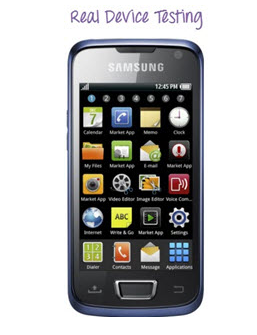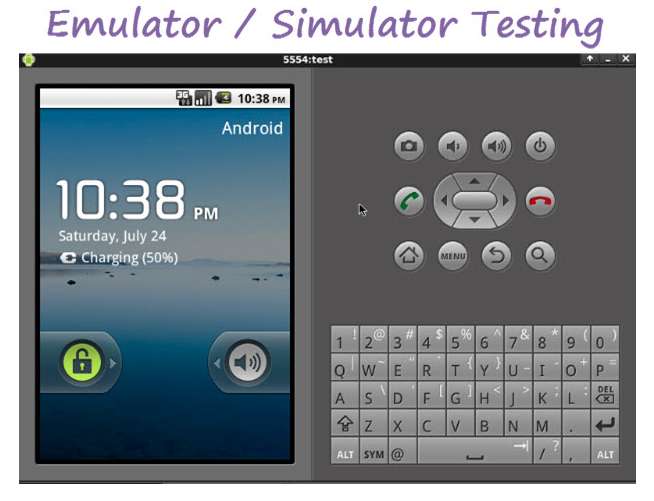1. What is test equipment?
Real-device testing allows running mobile applications and testing the device’s functionality. Real-device testing ensures that the application will work smoothly on the customer’s handset. 
2. What is an emulator?
An emulator is a software program that allows a mobile device to mimic the features of a computer or other mobile software that it needs to emulate by installing them on a computer or mobile device. 
3. Differences between Simulator and Emulator based on testing
Both the Emulator and Simulator are virtual devices. A virtual device is not a real phone but a software that functions similar to a real phone (except for some functions like a camera). But there are some differences between Emulator and Simulator as follows:
| Simulator | Emulator |
|---|---|
| Goal: simulate the internal state as close to the inner state of an inner object | The goal is to simulate or imitate as closely as possible the outer behavior of an object |
| Take priority whenever the test team needs to check the internal behavior of mobile devices such as internal hardware, firmware, etc. | Get priority whenever the testing team needs to check the external behavior of mobile devices such as calculations, transactions, etc. |
| Written in high-level language. | Written in assembly language (Assembly Language) |
| Difficult to debug errors | Suitable, easier to debug errors |
| just re-implement part of the original software. | Implement all the original software |
4. Advantages of testing based on real devices and Emulator / Simulator
| Problem | Tested by Emulator | Tested with real device |
|---|---|---|
| Application-based situations | In reality, there will be a situation: the time is short and the device purchase is not possible. Therefore, emulator / simulator should be used in this case to test the application | Real devices allow testers to test almost all situations for mobile applications. These devices are operated with a finger and simulate real-world use, helping to support checks in real-life contexts: is it easy to use the app on the train or when walking on the road? The situation of sunlight or in the rain? |
| The handset will be more friendly | In fact, due to the low budget and the faulty device interface, the investment in buying equipment for testing is limited. So the Emulator / simulator is used to solve this situation. | The actual device allows the tester to check even usability issues such as the interface of the application, the color resolution of the screen, whether the image is bright in both day and night conditions, etc. |
| Crickets used | Emulator / simulator in most cases is free and open software, can be easily downloaded from the Internet and ready for testing. | Real devices allow for rigorous performance issues to be tested, such as working with applications for 15 continuous hours, which cannot be emulated by emulators. |
| Easily open Web applications via URL | Web application testing is easier when opening web applications. Users just need to copy and paste the application URL. | Testing on real devices needs more in terms of reliability. |
| Screen capture of situations where errors appear | Taking a screenshot through the emulator is easy because just using Microsoft office utilities. | Testing with real-world devices is very useful in terms of interoperability testing. |
| Simulator in confirming the battery scenarios | Emulator / simulator cannot simulate battery problems. | True devices can easily execute battery scenarios |
| Confirm interrupt situations | Emulator / simulator cannot simulate interrupt situations such as receiving SMS, incoming calls | True devices can easily simulate interrupt situations |
| Confirm the display of the correct color | Emulator / simulator cannot accurately simulate / simulate the color display of equipment when it is in sunlight or in the dark. | True devices can easily simulate accurate color screens. |
| Performance confirmation | Emulator / simulator performance tends to be slower than real devices | Real devices tend to work faster than the Emulator / simulator. |
| Simulate memory-related problems | The available memory of the Emulator / simulator tends to go beyond real devices, so this can create misconceptions for users making similar assertions. | The memory storage level of devices tends to be much lower than that of the Emulator, thus being able to accurately identify memory-related problems. |
5. Disadvantages of Emulator / Simulator and real devices.
| Emulators / Simulators | Real equipment |
|---|---|
| Emulator / simulator is not always the best solution for scenarios, such as those where the test team needs to verify the performance of the application over a long period of time. | Devices are much more expensive than Emulator / simulator. Therefore, projects that are under budget and time constraints may have a risk of profitability as well as viability of the entire project. |
| The appropriate emulator / simulator is only suitable for certain functional test cases | There are many types of mobile devices from Apple, Samsung, Android and Symbian, etc. Consider which devices will be difficult for the testing team to have when budget and timeline constraints are involved. |
| Emulators / simulators sometimes cannot support certain types of applications, and in these cases the testing team may need to purchase software versions that are not always free and can sometimes be expensive. . | Real devices, when used at development stage for testing and similar purposes, may be more difficult to connect to the IDE than the emulator, and this can cause great problems for debugging and in a project. , with timeline constraints, this will most likely also hinder the progress of the project. |
| Not all emulators / simulators support all mobile applications. For example, the bada emulator supports Maemo (like Nokia N900), Symbian Touch (like Nokia N8) and Symbian non-touch (like Nokia E71) but it does not support other mobile devices like Android. The relevant application testing functions, bada does not support direct web browsing testing, but it allows users to test and create only web applications and widgets. | To check with real devices, devices need to be always connected to the device’s USB port. Therefore, if the USB port is not working properly, the test will not be performed. Without adequate security measures, mobile devices (such as Apple’s iPhone) could be lost or stolen, thus affecting the project. Increasing security can also increase the cost of the project |
| The user must enter the URL manually to open the web application to be tested. To solve this problem, the tester needs to create bookmarks, short URLs, or send the URL to a mobile device using Bluetooth connectivity or create a website containing some URLs. Adopting these procedures will ensure that the memory is not full, thus affecting the overall performance of the application. |
6. Conclusion
Due to the important role of mobile applications, today, in our daily lives, testing of these applications will be very developed, and so a lot of testing is required to make applications. Works on demand. Testing with Emulator / simulator as well as real devices is necessary to maintain standards and ensure quality.
Considering both the pros and cons of real emulators and devices, the optimal mobile testing solution for businesses is the optimal combination of both.
Emulator can be considered very suitable for the early development stages of the application.
However, in order to avoid costly expenses when an app has been released with an error, businesses need to ensure that the application has been tested on the actual device before release.
Every organization needs to plan and strategize to determine at which stage it will introduce real devices. They also need to decide how many devices are sufficient to meet the market needs and what is the best option that can be used to manage them.
Practice indicates that actual developers should use emulators (and some real handsets) to speed up the debugging of applications during the coding phase, while performing sanity tests, somke tests, performance test, interoperability and regression testing should be done on real devices.
In fact, developers will use the emulator to perform fast in the development stage, while the test team should test with real devices in the testing phase to ensure the targets and items. pepper overall quality. To save costs, they may consider using the Virtual Mobile Testing tool. These services are available to developers to test applications on multiple handsets using different mobile networks with geographic locations around the world (useful for applications that use GPS). Such services are provided at an hourly cost and are very effective compared to buying a new phone.
Reference link: https://www.guru99.com/real-device-vs-emulator-testing-ultimate-showdown.html
